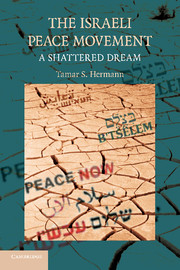Book contents
- Frontmatter
- Contents
- Acknowledgments
- 1 Introduction
- 2 Exploring Peace Activism – A Road Map
- 3 Mapping the Israeli Sociopolitical Terrain
- 4 Paving the Road to Oslo – Israeli Peace Activism through 1993
- 5 The Path Strewn with Obstacles (1993–2008)
- 6 A Path Finder – Exploring New Ways or Getting Lost?
- Appendix 1 List of Israeli Peace Groups
- Appendix 2 Israeli Jewish Public Opinion on the Oslo Process (1994–2008)
- Bibliography
- Index
5 - The Path Strewn with Obstacles (1993–2008)
Published online by Cambridge University Press: 08 January 2010
- Frontmatter
- Contents
- Acknowledgments
- 1 Introduction
- 2 Exploring Peace Activism – A Road Map
- 3 Mapping the Israeli Sociopolitical Terrain
- 4 Paving the Road to Oslo – Israeli Peace Activism through 1993
- 5 The Path Strewn with Obstacles (1993–2008)
- 6 A Path Finder – Exploring New Ways or Getting Lost?
- Appendix 1 List of Israeli Peace Groups
- Appendix 2 Israeli Jewish Public Opinion on the Oslo Process (1994–2008)
- Bibliography
- Index
Summary
Road Signs
As of this writing in summer 2008, we still lack the historical perspective needed to make conclusive statements regarding the nature and outcomes of the Oslo process. This process, which ended in escalating violence on both sides, could prove in retrospect to be the beginning of a slow but comprehensive peacemaking process. The opposite is no less likely, however; the Oslo process could prove to be merely an inconsequential interlude in the protracted violent conflict between Israel and the Arab world. Despite the lack of historical perspective, however, we can already discern six main segments of the Oslo road, each with its own topography, ups and downs, and with its specific opportunities structure as far as the peace movement was concerned:
The rest area zone – fall 1993–late 1995
The bumpy zone – early 1996–mid 1999
The checkpoint zone – mid-1999–summer 2000
The dark tunnel zone – fall 2000–early 2003
The dead-end point – early 2003–summer 2008
In part, as everyone familiar with Israeli electoral history can see, this periodization corresponds with the government of the various prime ministers of the time – Rabin, Peres, Netanyahu, Barak, and Sharon. The correlation is not perfect, however, because the multifaceted situation facing the peace movement is influenced by more than only the top person or the party in power.
Clearly, any periodization of this sort is oversimplistic, because structural conditions, political phenomena, and societal interactions do not simply appear and disappear on a specific date.
- Type
- Chapter
- Information
- The Israeli Peace MovementA Shattered Dream, pp. 111 - 239Publisher: Cambridge University PressPrint publication year: 2009

